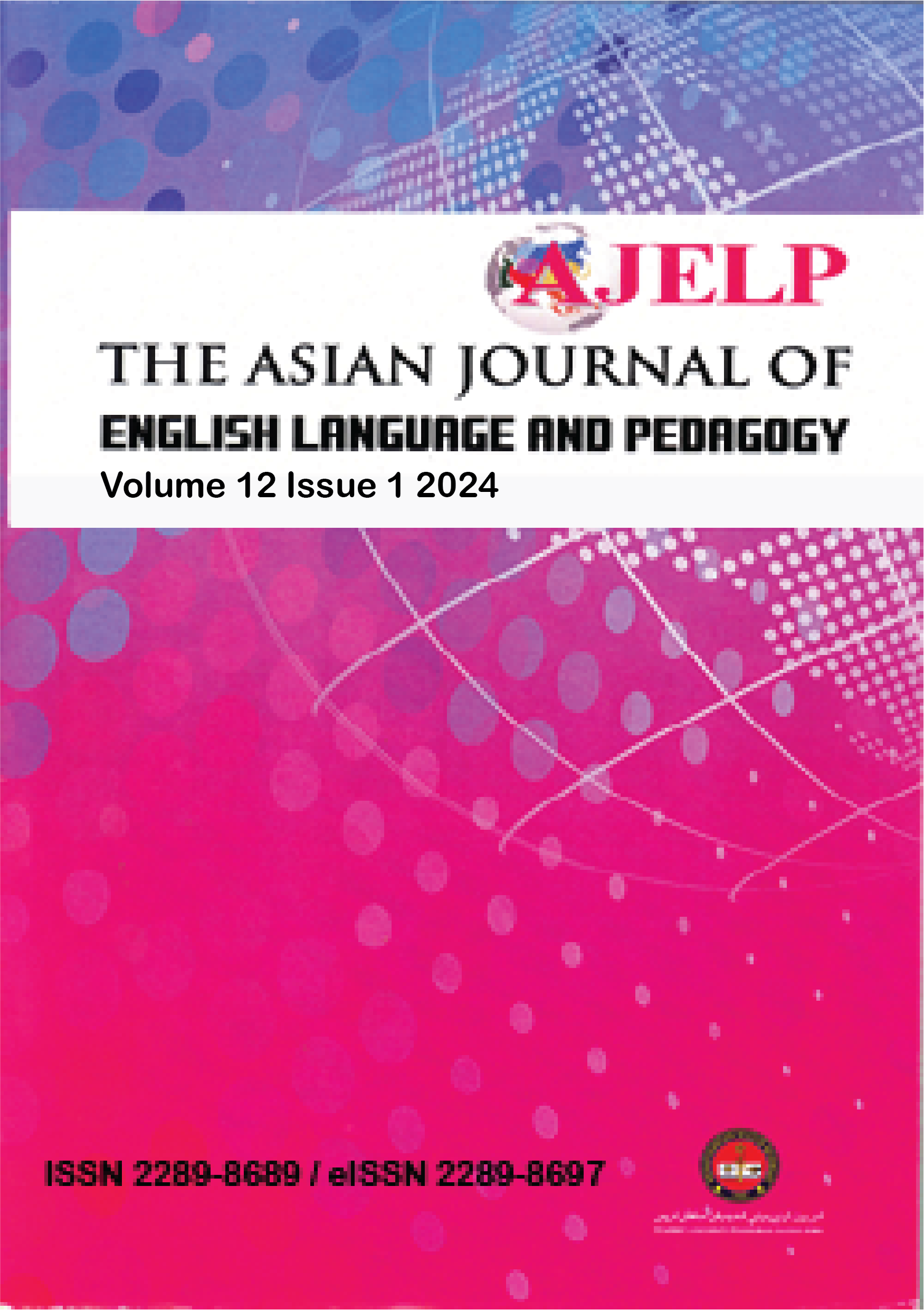Exploring the Relationship between Students’ Perfectionism and Their Use of Translation Strategies
DOI:
https://doi.org/10.37134/ajelp.vol12.1.3.2024Keywords:
Perfectionism, Translation Strategies, Translation Students, Translation TrainingAbstract
Focusing on translators' personal characteristics and their individual differences has gained more momentum in the quest for exploring factors influencing the translation process. The present study aimed to examine the relationship between translator trainees' perfectionism and their preference for the use of different translation strategies. For so doing, 100 translation students were recruited and asked to fill Multidimensional Perfectionism Scale (Hewitt et al.1991) and to choose one of the suggested translations for two sets of texts designed based on the translation strategies proposed by Vinay and Darblenet (1995) and Venuti (1995). The data were analyzed using SPSS (22) and Smart PLS (3.0) software packages. The findings showed that perfectionism influenced the translation trainees' preference in using some translation strategies like literal translation, domestication, and foreignization. The findings were discussed and the pedagogical implications were made.
Downloads
References
Barabadi, E., & Khajavy, G. H. (2020). Perfectionism and foreign language achievement: The mediating role of emotions and achievement goals. Studies in Educational Evaluation, 65, 100874. DOI:10.1016/j.stueduc.2020.100874
Barboni, T. (1999). ‘Inconscient et traduction’, ThéorieetPratique de la Traduction III – La Traduction Littéraire: L’Atelier du traducteur, Lejeune, C. (ed.), Mons: Le Ciephum, 23-33
Brophy, J. (1996). Working with perfectionist students. ERIC Clearinghouse.
Flett, G. L., & Hewitt, P. L. (2002). Perfectionism: Theory, research, and treatment. American Psychological Association. https://doi.org/10.1037/10458-000
Flett, G. L., Hewitt, P. L., Shapiro, B., & Rayman, J. (2001). Perfectionism, beliefs, and adjustment in dating relationships. Current Psychology, 20, 289- 311. doi:10.1007/s12144-001-1013-4.
Gaines Jr, S. O. (2016). Personality and close relationship processes. Cambridge University Press.
Gevaert, M. (2020). Personality in translation an experimental study of the relationship between personality traits of student translators and translation quality (Mémoire de master non publiée). Université de Gand, Gand.
Gile, D. (2009). Basic concepts and models for interpreter and translator training. Basic Concepts and Models for Interpreter and Translator Training, 1-299.
Goodwin, C. J., & Goodwin, K. A. (2016). Research in psychology methods and design. John Wiley & Sons.
Gregersen, T., & Horwitz, E. K. (2002). Language learning and perfectionism: Anxious and non‐anxious language learners' reactions to their own oral performance. The Modern Language Journal, 86(4), 562-570. DOI:10.1111/1540-4781.00161
Hewitt, P. L., & Flett, G. L. (1991). Perfectionism in the self and social contexts: conceptualization, assessment, and association with psychopathology. Journal of Personality and Social Psychology, 60(3), 456. https://doi.org/10.1037/0022-3514.60.3.456
Hewitt, P. L., Flett, G. L., Turnbull-Donovan, W., & Mikail, S. F. (1991). The Multidimensional Perfectionism Scale: Reliability, validity, and psychometric properties in psychiatric samples. Psychological Assessment: A Journal of Consulting and Clinical Psychology, 3(3), 464. https://doi.org/10.1037/1040-3590.3.3.464
Hollender, M. H. (1978). Perfectionism, a neglected personality trait. The Journal of clinical psychiatry, 39(5), 384-384.
Hubscher-Davidson, S. (2007). An empirical investigation into the effects of personality on the performance of French to English student translators (Unpublished doctoral Tesis). University of Bath, Inglaterra.
Lörscher, W. (1991). Translation Performance, Translation Process and Translation Strategies: A Psycholinguistics Investigation. Tubingen: Gunter Narr. https://doi.org/10.1075/babel.38.4.16dan
Lörscher, W. (2005). The translation process: Methods and problems of its investigation. Meta: Journal des traducteurs/Meta: Translators' Journal, 50(2), 597-608. https://doi.org/10.7202/011003ar
Munday, J. (2012). Introducing translation studies: Theories and application. Authors (removed for blind peer review) https://doi.org/10.4324/9781315691862
Navidinia, H., Imani, P., & Mobaraki, M. (2021). Exploring the relationship between translation students’ personality characteristics and their preference for using translation strategies. Indonesian Journal of Applied Linguistics, 11(2), 341-350. https://doi.org/10.17509/ijal.v11i2.23985
Navidinia, H., Kazemi, T. & Ghazanfari, M. (2019). Uncovering the Influence of EFL Students’ Perfectionism and Anxiety on their Willingness to Communicate in Language Classes. Iranian Journal of Applied Language Studies, 11 (1), 93-112.
Pacht, A. R. (1984). Reflections on perfection. American Psychologist, 39(4), 386. https://doi.org/10.1037/0003-066X.39.4.386
Pishghadam, R., & Akhondpoor, F. (2011). Learner Perfectionism and its Role in Foreign
Language Learning Success, Academic Achievement, and Learner Anxiety. Journal of Language Teaching & Research, 2(2). https://doi:10.4304/jltr.2.2.432-440
Pourgharib, B., & Dehbandi, Z. (2013). The impact of translator’s personality on translation quality of narrative texts. International Journal of Basic Sciences & Applied Research, 2(4), 417-422.
Qiu, G. (2023). Towards the effects of translators’ emotional intelligence and anxiety on their translation quality. Heliyon. https://doi.org/10.1016/j.heliyon.2023.e19276
Reiss, K. (2000). Translation Criticism: The Potentials and Limitations: Categories and Criteria for Translation Quality Assessment. (Translated by Erroll, FR). St. Jerome.
Ringle, C. M., Wende, S., & Becker, J. M. (2015). SmartPLS 3. SmartPLS GmbH, Boenningstedt. Journal of Service Science and Management, 10(3), 32-49.
Saridaki, E. (2021). Vinay & Darbelnet’s translation techniques: A critical approach to their classification model of translation strategies. International Journal of Latest Research In Humanities And Social Science, 135-137.
Schleiermacher, F. (1813/2004). On the different methods of translating, in L. Venuti (ed.) (2012) The Translation Studies Reader, 2nd edition, 43–63.
Schuler, P. A. (2000). Perfectionism and gifted adolescents. Journal of secondary gifted education, 11(4), 183-196. https://doi.org/10.4219/jsge-2000-62
Temme, D., Kreis, H., & Hildebrandt, L. (2006). PLS path modeling: A software review (No. 2006, 084). SFB 649 discussion paper.
Tirkkonen-Condit, S. (1997). Who verbalises what: A linguistic analysis of TAP texts. Target. International Journal of Translation Studies, 9(1), 69-84. https://doi.org/10.1075/target.9.1.05tir
Venuti, L. (1995). The translator’s invisibility: a history of translation. London and New York: Routledge.
Venuti, L. (1998). Strategies of translation. Encyclopedia of translation studies, 240-244.
Venuti, L. (2012). The translation studies reader. Routledge.
Vinay, J. P., & Darbelnet, J. (1995). Comparative stylistics of French and English: A methodology for translation (Vol. 11). John Benjamins Publishing. https://doi.org/10.1075/btl.11
Downloads
Published
How to Cite
Issue
Section
License
Copyright (c) 2024 Parisa Imani, Hossein Navidinia, Mohsen Mobaraki

This work is licensed under a Creative Commons Attribution-NonCommercial-ShareAlike 4.0 International License.





